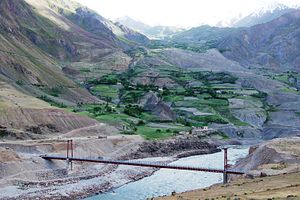On Monday, the government of Tajikistan endorsed a draft agreement that would see China build several border posts. According to Reuters, Dushanbe published a decree ordering the State National Security Committee to sign an agreement with China “which provides for the construction of eleven outposts of different sizes and a training center for border guards.”
China has increased its aid and investment in Central Asia over the last few years in conjunction with the Silk Road Economic Belt (SREB) initiative. While much of China’s investment in the region has been in Kazakhstan–the region’s most advanced economy and the most logical stepping stone on the road to Europe–Tajikistan has received increased attention of late.
Tajikistan was among the first four projects announced by the China-led Asian Infrastructure Investment Bank (AIIB). The AIIB was proposed by Beijing in 2013 and opened for business in January 2016. This summer, the AIIB announced its initial projects: in Indonesia, Tajikistan, Bangladesh, and Pakistan.
The AIIB project in Tajikistan, cofinanced with the European Bank for Reconstruction and Development (EBRD) aims to improve a 5 km section of road connecting Dushanbe to the Uzbek border. The EBRD will administer the $105.9 million project on behalf of the AIIB.
Provided the recently-announced border project goes forward, that makes two Tajik borders on the receiving end of Chinese funding of some kind.
The 1,345-kilometer Tajik-Afghan border–in part defined by the meandering Panj river–is as porous as it is mountainous, a fact exploited to great profit drug smugglers looking to move Afghanistan’s infamous poppy haul out into the world. This fact worries officials in both Dushanbe and Kabul, not to mention Washington and increasingly Beijing, who see the frightening opportunity for smuggling routes to be used by insurgents and terrorists.
The intensification of the Afghan war in the country’s north–illustrated best by the brief, but shocking, seizure of Kunduz last year by Taliban–reignited Central Asian nerves about the border. Not that they’d ever been calm. It’s a favored pastime of Central Asian governments to complain about the Afghan border; ”spillover” is the term of choice, though last year several warned of an impending “invasion” of ISIS fighters from Afghanistan. Instances of hyperbole aside, the border is difficult to secure, given the terrain, and the border services not well-equipped or well-trained.
China has demonstrated growing interest in Afghanistan, joining with the United States, Afghanistan, and Pakistan to participate in the Quadrilateral Coordination Group (QCG), aimed at pursuing, in the words of the U.S. State Department, “mutual efforts to facilitate an Afghan-led and Afghan-owned peace and reconciliation process with a view to achieving lasting peace and stability in Afghanistan and the region.” Although the QCG has failed to forge peace in Afghanistan (who hasn’t?), China’s participation underscored the country’s growing interests in the region and the importance of stability in Afghanistan to capitalizing on Beijing’s aims in nearby countries.
Tajikistan looks to benefit from China’s concerns about Afghanistan. Beijing will join a long list of largely Western-funded projects to bolster border security and instill competence in the Tajik border service. Whether the Chinese efforts will have a measurable impact on the solidity of the border, time will tell.

































